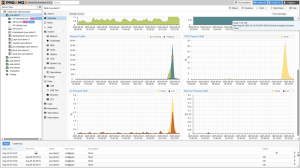Availability of Proxmox Virtual Environment V.9.0 with Debian 13
With snapshots for thick-provisioned LVM shared storage, new fabrics feature for SDN stack, affinity rules in HA clusters, and enhanced mobile interface
This is a Press Release edited by StorageNewsletter.com on August 21, 2025 at 2:01 pmProxmox Server Solutions GmbH, celebrating its 20th year of innovation, announced the release of Proxmox Virtual Environment (VE) 9.0.
Main highlight of this update is a modernized core built upon Debian 13 ‘Trixie’, ensuring a robust foundation for the platform.
Proxmox VE 9.0 further introduces significant advancements in both storage and networking capabilities, addressing critical enterprise demands. A highlight is the long-awaited support for snapshots on thick-provisioned LVM shared storage, improving storage management capabilities especially for enterprise users with FC or iSCSI SAN environments. With newly added ‘fabric’ support for Software-Defined Networking (SDN), administrators can construct highly complex and scalable network architectures.
Click to enlarge
Highlights in Proxmox Virtual Environment 9.0:
- Debian 13 ‘Trixie’ at the core
This core update is based on Debian 13 ‘Trixie’, bringing the latest Debian release as foundation for Proxmox VE including newer packages, improved hardware support, and enhanced security. Proxmox VE is using a newer Linux kernel 6.14.8-2 as stable default enhancing hardware compatibility and performance.
Also, updates to the latest versions of leading open-source technologies for virtual environments like QEMU 10.0.2, LXC 6.0.4, Ceph Squid 19.2.3, and ZFS 2.3.3 are included. ZFS now supports adding new devices to existing RAIDZ pools with minimal downtime. For existing users of Proxmox VE 8.4 or older versions, an extensively tested and detailed upgrade path is available to enable a smooth upgrade.
- Snapshots for thick-provisioned LVM shared storage
VMs utilizing thick-provisioned LVM shared storages, such as those backed by iSCSI or FC-based SANs, now benefit from snapshot functionality out of the box. This is achieved by implementing snapshots as volume chains, where a volume based on a snapshot only records differences to its parent snapshot volume. Directory, NFS, and CIFS storages also gain additional support for snapshots as volume chains.
This new feature provides a powerful and highly requested capability for customers with traditional SAN infrastructure who have historically relied on clustered file systems. While direct integrations from many storage vendors continue to grow, this new feature closes the gap by providing a storage-independent solution for snapshots. This gives customers the independence to seamlessly manage their snapshots regardless of their hardware, without compromising on convenience.
- New Fabrics feature for SDN stack
This release enhances the SDN capabilities with the introduction of an SDN Fabrics feature, designed to simplify the configuration and management of complex routed networks. Engineered for reliability, SDN Fabrics facilitates multiple paths between nodes and automatic failover across NICs, enabling the configuration of robust 2-layer spine-leaf architectures for improved network redundancy and performance.
This new feature simplifies the management of dynamically routed networks which can for example be used as Ethernet VPN (EVPN) underlay or full-mesh networks for Ceph. The SDN stack in Proxmox VE gains support for 2 different routing protocols, OpenFabric and OSPF, and provides intuitive tools for the simplified configuration and precise management of those dynamic routing protocols.
- Affinity rules in HA clusters
The company’s team introduces HA resource affinity rules to enable fine-grained control and flexibility over resource placement in HA clusters, ensuring optimal performance, enhanced resiliency, and minimized latency for critical workloads. To better control complex, interconnected applications, the new HA Resource Affinity Rules allow administrators to precisely define how VMs and other HA resources are distributed across a cluster.
Interdependent HA resources, such as for example an application server and its associated database, can be kept together on the same physical node to minimize network latency. For services requiring maximum redundancy, like multiple VMs running the same mission-critical application, the rules can ensure these instances are kept on different nodes. This increases fault tolerance and ensures resiliency even during HA failovers.
- Enhanced mobile interface
The Proxmox VE mobile interface has been thoroughly reworked, using the new Proxmox widget toolkit powered by the Rust-based Yew framework. The redesigned interface provides quick access to service overviews and includes essential management functions, including starting and stopping virtual guests and basic configuration. It is now easier than ever for users to access fundamental functionalities of Proxmox VE directly from their mobile browsers.
Availability:
Proxmox VE 9.0 is available for download. The ISO contains the complete feature-set and can be installed on bare-metal. The virtualization platform from the company comes stocked with all the essential management tools, as well as an easy-to-use, web-based user interface. This allows for simple, out-of-the-box management of the host, either through the command line or a standard web browser.
Upgrade instructions from Proxmox VE 8 to 9 are available. It’s also possible to install Proxmox VE 9.0 on top of Debian.
License: Proxmox Virtual Environment is free and open-source software, published under the GNU Affero General Public License, v3.
Support Subscriptions: For enterprise users, the company offers a subscription-based support model, which provides access to the extensively tested Enterprise Repository, with regular updates via the web interface, as well as technical support on a subscription basis. Prices start at €115/year and CPU.
Resources:
ISO Image Download
Roadmap: For published and upcoming features
Video: What’s new in Proxmox VE 9.0















 Subscribe to our free daily newsletter
Subscribe to our free daily newsletter

